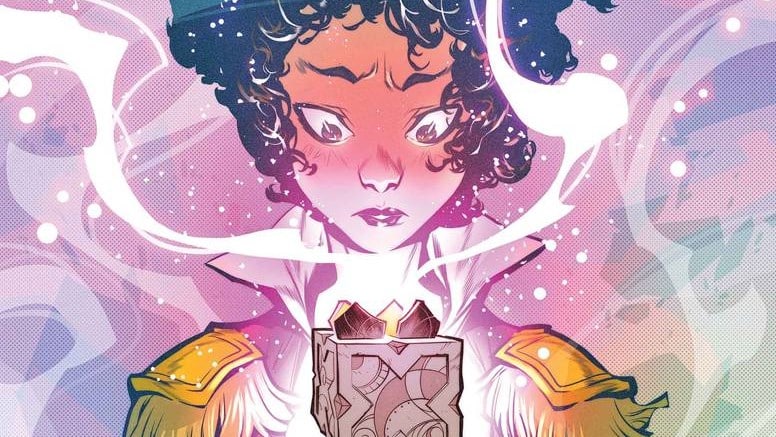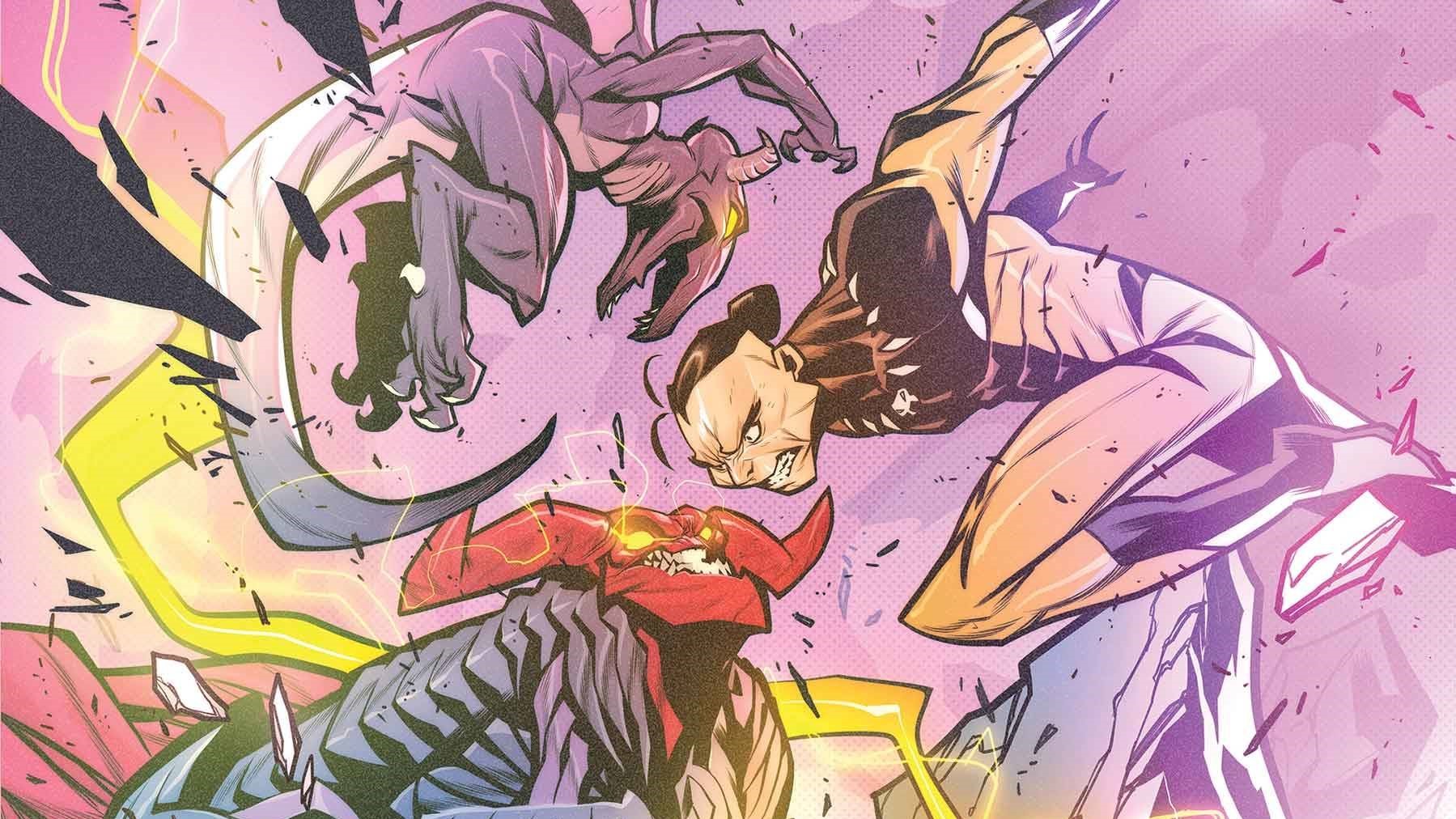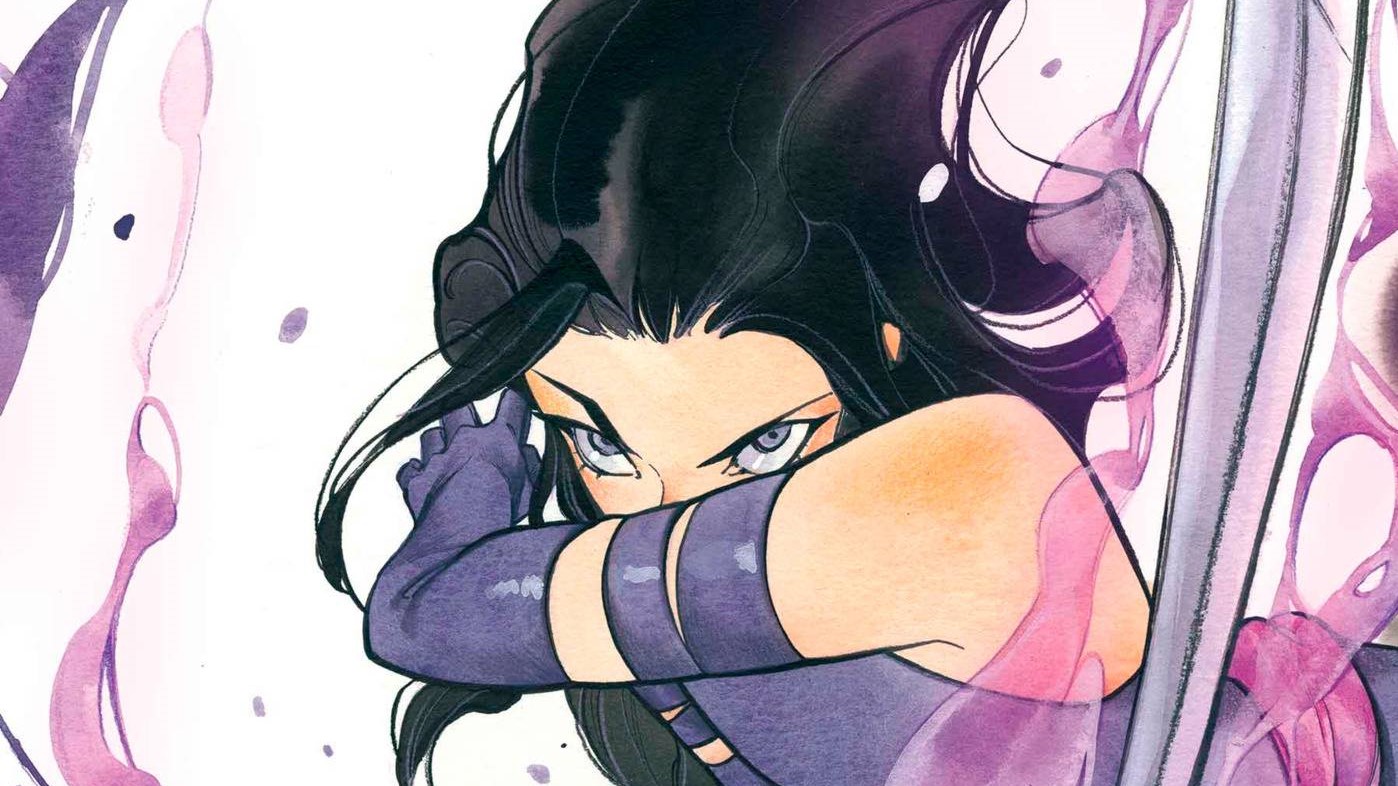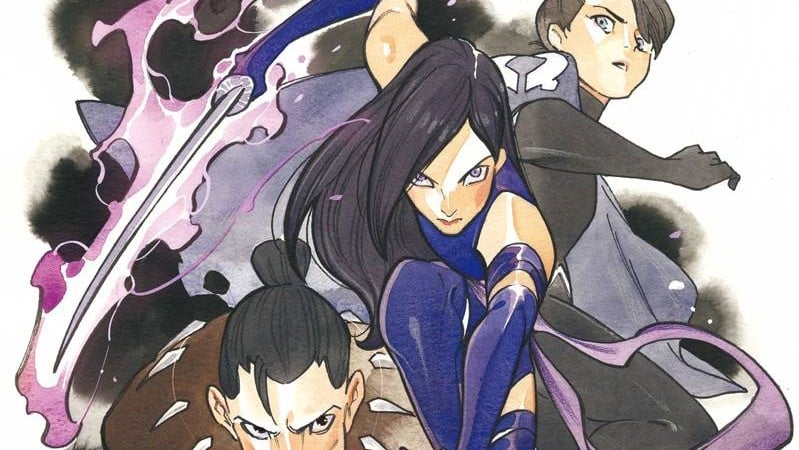Inconceivably long ago in the history of the Earth, the mutants (Enriched) and the non-mutant humans (Enshrined) of the community called Threshhold battle the anaerobes of the Unbreathing and the genocidal megabacteria Arkaea and Sublime. Our Marauders have come, in sealed suits, from the future to save their kin. Some will die, some will live, and nobody knows what comes next in Marauders #9, written by Steve Orlando, drawn by Eleanora Carlini, colors by Matt Milla, letters by VC’s Ariana Maher.
Ian Gregory: The Marauders have gone back to save Threshold, and things are going totally great. Marauders #9 is just a happy, feel-good issue in which nobody dies, is vaporized, or otherwise dragged from the timestream. Aren’t you glad to see our friends again?
Stephanie Burt: I’d love to see their friendly faces. Unfortunately they’re in full-body spacesuits with semi-translucent helmets. I guess we’ll see what we can get.
Talk Your Talk and Go Viral

Ian: Marauders #9 opens on the big fight with Sublime, picking up from where he killed and subsumed Fang. In a series that I think has done well with original, interesting fight scenes, I found this one to be pretty boring. Sublime is just a big dude with blue Strong Guy-esque hair and the Marauders take turns whaling on him over the course of two pages before he’s defeated. As far as the action goes, this was fairly uninspired.
Stephanie: He has more hair than Strong Guy. But he’s a lot less fun to watch. I found this fight scene delightfully colorful, but also actively confusing: we’ve got so many actors in the same space, and all the good guys wear full face-obscuring helmets. The sealed bodysuit have names down one leg, but we barely (see what I did there?) ever see them, except for one crystal-clear AURORA.
Ian: All that said, I did like the scene between Somnus and Fang in the dreamspace. I think Orlando does a good job showing that, even if death is a solved problem, it still affects those around you. Previously, I’ve felt that characters have died with too little fanfare. I like seeing here that, in fact, watching your friends and loved ones die would be traumatic even if they can come back.
Stephanie: Agreed. Somnus wants to save his beloved from the pain that likely accompanies death. And I guess he succeeds? It’s one of the few quiet interpersonal moments in this crowded biopunk archeo-space-earth-opera plot-heavy issue.
Ian: With Sublime defeated, Arkea appears (and how nice of the villains to take turns!), and an invader force of the Unbreathing enter the fray as well. Aurora does a cool move. They all escape through a portal of nebulous origins, and in the process, Amass is grabbed and Kate disappears. This sequence was a little confusing – how did they get out, exactly? Somehow, Amass is responsible for that, and I had to go back and check that his powers only include combining mutants and not portals or teleportation.
Stephanie: I don’t know. I think it had to do with Aurora’s super-speed powers? A lot of people and things go by at the end of this multi-front battle. Whoosh!
Ian: It definitely doesn’t help that, as you pointed out, the tinted faceplates make it almost impossible to tell the characters apart in some scenes. It’s one thing to give everyone matching uniforms, but if we can’t see their faces (or even their hair!) then there’s no visual clarity whatsoever.
You’re On Your Own, Kid

Ian: Our heroes end up at Helix Home, Threshold’s local equivalent to Yavin IV. There, they meet Grove, the leader of Threshold’s resistance. He arrives at a convenient moment, derailing all of the Marauders’ doubts about this mission. The resistance consists of both Enhanced (mutants) and Enshrined (humans), and we also get a look at the very time capsule that sent the Marauders on this mission in the first place. That’s a nice little loop-closer, and I think it’s indicative of the care Orlando has put into this story, even if I don’t enjoy all the beats. What did you make of Grove, Stephanie?
Stephanie: I have passed the test. I shall diminish, and go into the West, and remain Galadriel. Oh, sorry, I thought you were asking what I made of the final chapters in The Fellowship of the Ring, because this story beat feels so much like that story beat. Which is absolutely fine, in itself — there’s something Tolkienesque about this whole arc! — and there’s nothing wrong with taking shelter in the secret domain of an absolutely trustworthy Earth-mother type while you lick your wounds and plan your next moves. But I dislike the visuals. It’s 2022, and there’s truly no reason why the sheltering mother of all the remaining Enshrined and Enhanced should look so tall, skinny, conventionally elven, and Nordic. I wish she had tentacles. Or scars. Or an ounce of body fat. Something.
Ian: In Helix Home, we see Threshold’s secret weapon, the Daymight. They claim that this giant light cannon will simply destroy all of the enemy’s “Nightguns,” but will not obliterate them completely, like their attempt with the biological weapons. I can’t help but wonder if Threshold has only learned its lesson in terms of minimizing risk to themselves, not because they see anything morally wrong with genociding the Unbreathing and bacteria. This perspective is reinforced, in my opinion, by the Rome-like senate speeches we see in the second data page. Do you think my suspicion of Threshold is justified, or am I just being paranoid?
Stephanie: Well, they’re fighting for existential survival, and their Unbreathing opponents seem to have made clear that it’s a them-or-us situation. Maybe my memory’s failing in my old age, but how much did we learn, last issue, about nightguns? Or about the darkforce, which either keeps the Unbreathing alive or powers their weapons? Also, there’s a subplot about the relative voting power of the Enshrined (humans) and the Enhanced (mutants) in the Threshold’s equivalent of Parliament. And if everyone used to have a mutation until the Enshrined (plain old humans) came along later, what does the word “enhanced” even mean? Why use it? But hey, everybody speaks English anyway in this version of the Earth’s first age. [Throws up hands.]
Ian: We also learn that Arkea has infected the spawning pool from which both mutants and humans are born. The squad puts together a, in my opinion, totally nonsensical plan where Bishop is going to absorb the electric charge of the birthing cells (???) in order to purge Arkea. I think Kate’s disappearance has totally thrown the Marauders into disarray. This is evidence that, even if Kate has been kind of pushy about missions, she has a talent for both leading and reading people. Without her, I feel like the Marauders are just going along for the ride.
Stephanie: I think the plan, translated into something that looks a bit more like real science, is: Bishop zaps the water in the birthing pool so hard that all the cells in it, including the bacterial cells, just die. That makes the birthing pool clean and ready to use. Of course, it also means who knows what other chemical reactions take place in it. But look: Kate Pryde’s gone. And Kate has a PhD from the University of Chicago in physics. She exudes a field of believability, so that when she’s on-page the fake superhero science has the veneer of sense. Now she’s gone, and it makes something close to no sense. (Throws up hands again.) Also, Theia’s flirting with Kwannon/Psylocke, which… how long have they known each other at this point? Isn’t Aurora the one with super-speed?
Ian: Somnus also flirts with Grove, and I feel like these people need to get their priorities together. There’s definitely been a lot of romantic undertones going on in these issues, which feels very out of place considering the rest of the story and the urgency of Marauders #9 in particular. Amass has been caught by the Unbreathing, and their mutant leader Commander Nightfount, who evidently defected from Threshold. I love the design on the Unbreathing with their giant crystal helmets protecting their fungal heads from the air. I like getting this perspective on the Unbreathing, even if it is from another mutant and not in their own words. And then, we get to the big last-page twist.
It’s Me, Hi, I’m the Problem, It’s Me

Ian: I need you to believe me, Stephanie, when I say that I totally called this twist as early as page one. When we first see Nightfount and his Majordomo, my Liefeld-addled brain literally went “Wow, this looks a lot like that classic panel of Stryfe on his throne with Zero standing behind him.” Then, Nightfount uses the term “mutant” to describe Threshold, which I thought was super odd because that’s been established as a distinctly modern term. Lastly, I thought his helmet was vaguely Stryfe-like. When Nightfount pulled off said helmet and revealed himself as Stryfe, Stephanie, let me tell you, I almost completely lost it.
Stephanie: Well, I did ask for tentacles, which this version of Stryfe appears to have grown. I do like the art! It’s bonkers! Eleanora Carlini just gets to draw whatever biopunk nonsense looks good to her! And I’ve figured out why you have more patience for this tangled-up plot than I have at this point (I’ve been giving the benefit of the doubt). It’s a fast-moving, world-shaking, 1990s comic, where everyone flies and everything happens fast. I stopped reading X-comics in 1989 and only came back in the 2000s. So I’ve caught up on the 1990s here and there (ask me about Generation X) but I certainly did not grow up with them. Stryfe presses none of my nostalgia buttons. I’d rather watch Scott Summers sip soup.
Ian: I’m a huge mark for Cable, and therefore for all Stryfe-related nonsense. Arkea and Sublime felt kind of underwhelming as antagonists, and so his appearance here really felt like an infusion of energy. The X-Men can time travel, sure, but so can the bad guys. Where else would Stryfe be but the place in time where he can cause the most conflict? If the heroes get to play around with time traveling to rescue mutants, I like that they have opposition on equal footing.
Stephanie: Sure, why not? But does Stryfe himself have to breathe? Can we get a timeline? Why is he holding what appears to be a fully mechanized crab?
Ian: I highly doubt Stryfe intends to stick around any more than a few seconds after igniting the atmosphere. I don’t quite know how Crave knows who Stryfe is. I went back to previous chapters and wasn’t able to stop him being mentioned, which implies to me that Stryfe is so notoriously evil that somehow even Threshold knows about him. Good for Stryfe! He’s really getting that brand out there.
Stephanie: Let me see if I’ve got this all right. The people of Threshold, who breathe oxygenated air. include Enhanced (mutants) and Enshrined (non-mutant humans), and they’ve been pushed back to the point where they live only in the Helix, whose host or maitre d’ or prime minister (it’s not clear which) is Grove. The Unbreathing now live underwater. They use nightguns. The Threshhold invented superbacteria as weapons to end the war with the Unbreathing, but the bacteria turned into Arkea and Sublime, who hate each other but agree in wanting to take over the world. The Unbreathing aligned themselves with the bacteria, and with Stryfe, who’s been going by Nightfount, and who’s apparently willing to kill everyone and everything by setting all the oxygen on fire. Also Cassandra Nova, who threatens Grove and hates the Helix principle of mutant-human coexistence, has a secret psychic link with Crave, who calls her his aunt. [Throws up hands]
Ian: I’m pretty sure that’s right, but there’s been very little elaboration about how the nightguns work, and also the timeline of the war with the Unbreathing and the creation of the killer bacteria. Also, I was a little disappointed that Stryfe was aligned with the Unbreathing, thereby making them into standard villains. There’s something to the idea that Threshold itself was a colonizing nation, one which sought to destroy the Unbreathing and in doing so created a warrior slave race that is now in the process of rebelling.
The Unbreathing weren’t villains, so far as we knew, except in the narrations of the biased Threshold mutants. Marauders #9 especially solidified the idea that the Marauders really don’t know anything about this mutant society they’ve come back to save, and they might be stepping into a complex political situation with absolutely no context and end up making a mess of things.
Stephanie: It’s a mess for sure. But I’m afraid that this issue puts readers, at least for the moment, in the same position as our timelost heroes: we don’t know enough about what’s going on. Or maybe we would, if we had read enough early 1990s comics and could predict Stryfe’s next move.
Our Flag Means Notes:
- Stryfe’s crab-and-barnacle armor is so cool, people. Dude’s got style.
- Threshold elders, according to a text page, belong to the Gasping Generation, because they lived through the Oxygen Wars. Smoking is for losers!
- I’ve been down on the plot and the pace so I, Stephanie, wish to emphasize again that Eleanora Carlini’s otherworldly settings and battle scenes work very well. She should draw science fiction nonsense more often!







